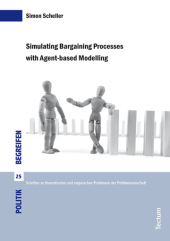 Neuerscheinungen 2016Stand: 2020-02-01 |
Schnellsuche
ISBN/Stichwort/Autor
|
Herderstraße 10
10625 Berlin
Tel.: 030 315 714 16
Fax 030 315 714 14
info@buchspektrum.de |

Volker Kunz, Johannes Marx, Simon Scheller, Annette Schmitz
(Beteiligte)
Simulating Bargaining Processes with Agent-based Modelling
Herausgegeben von Marx, Johannes; Schmitz, Annette; Kunz, Volker
2016. 126 S. mit 39, teilw. farb. Grafiken und Diagrammen. 21 cm
Verlag/Jahr: TECTUM-VERLAG 2016
ISBN: 3-8288-3749-2 (3828837492)
Neue ISBN: 978-3-8288-3749-2 (9783828837492)
Preis und Lieferzeit: Bitte klicken
Bargaining is a ubiquitous feature of social and economic interactions, and also a frequent object of academic study. Simon Scheller discusses a broad canon of formal models and critically assesses their methodological foundations as well as their potential for application. Standard game theoretic equilibrium concepts are shown to exhibit certain theoretical shortfalls, especially when it comes to assumptions about agents´ reasoning capacities. As an alternative, Scheller presents an Agent-based model which simulates bargaining among boundedly rational actors in a situation of iterated encounters. He shows how aggressive and stubborn behaviour can lead to asymmetric equilibria, and what this means for the emergence of inequality in society. The book pursues two main goals. From a methodological point of view, game theoretic models and agent-based models are comparatively analysed. This provides an insightful case study about the vices and virtues of both methods with regards to the trade-off between analytic rigour and descriptive detail. From a practical point of view, valuable insights can be drawn about different strategies´ success, fairness and efficiency. It is shown how those properties change with environmental circumstances.
1 Introduction
2 Game Theoretic Bargaining Models
2.1 The status of Game Theory
2.2 Simple Bargaining Games
2.2.1 The Ultimatum game
2.2.2 The Nash demand game
2.2.3 The Zeuthen-Harsanyi game
2.2.4 The Rubinstein bargaining game
2.3 Bargaining models with incomplete information
2.3.1 A model of mechanism choice
2.3.2 Sequential bargaining under incomplete information
2.4 Models of two-level bargaining
2.4.1 Schelling´s idea
2.4.2 Putnam´s model
2.4.3 Iida´s model
2.4.4 Iida´s model with asymmetric information
2.5 Bargaining for more than two players
2.5.1 The Shapley-Shubik power index
2.5.2 The Banzhaf-index
2.5.3 Generalisations of previous models for n players
2.6 Insights from game theoretic bargaining models
2.7 Problems with game theoretic bargaining models
2.7.1 Analytical solutions and realistic setups
2.8 Fundamental problems with the equilibrium concept
2.8.1 Disregard of dynamic interactions
3 Agent-based Modelling as an alternative approach to bargaining
3.1 The fundamental idea of ABM
3.2 Generative explanations
3.2.1 ABM for complex systems
3.3 The Methodology of ABM
3.3.1 Criteria for good models
3.3.2 Types of ABMs
3.3.3 The modelling cycle
3.3.4 Iterative model improvement.
3.3.5 Verification and Validation
3.3.6 The ODD protocol
3.4 Typical elements of ABMs
3.4.1 Heterogeneity.
3.4.2 Bounded rationality
3.4.3 Learning.
3.4.4 Fitness and Evolution
3.4.5 Network structures.
3.4.6 Spatial structures and local interactions
3.5 Advantages and problems of ABM: Hypothetical Experiments
4 A new bargaining model
4.1 Refined research question and preliminary hypotheses
4.2 Scope and relevance of the questions
4.3 ABM as an appropriate method for the study of bargaining
4.4 Presenting the model in the ODD framework
4.4.1 Overview
4.4.2 Design
4.4.2.1 Secondary-strategy parameters
4.4.2.2 Main strategies
4.4.2.3 Relating hypotheses to model entities
4.4.3 Details: The experiment
4.5 Neglected alternatives
5 Results
5.1 Initial Experiment
5.1.1 Performance of main strategies
5.1.2 Effect of Secondary strategy parameters
5.1.2.1 Prudence
5.1.2.2 Starting-demand
5.1.2.3 Minimal-demand
5.1.2.4 Other strategy-specific parameters
5.2 Initial experiment without prudence
5.2.1 Main strategy
5.2.2 Starting-demand.
5.2.3 Interpreting prudence as systematic bias
5.2.4 Conclusions from the initial experiments
5.3 Extended experiment
5.4 Altering the player Constellation.
5.4.1 Top6
5.4.2 All 6 hostile
5.4.3 Top 6 hostile
5.4.4 Summary of results
5.5 Hypothesis evaluation: Individual success
5.6 Hypothesis evaluation: Efficiency of outcomes
5.7 Hypothesis Evaluation: Equality of outcomes
6 Practical Implications
7 Comparison of different methodologies
8 Conclusion
9 References


